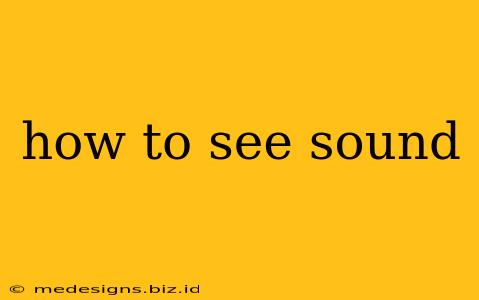Have you ever wondered how sound, an invisible force, can be made visible? While you can't literally see sound in the way you see a tree or a car, you can visualize its effects and properties through various methods. This opens up a fascinating world of understanding how sound waves behave and interact. This guide will explore several ways to make sound visible, from simple DIY experiments to sophisticated technological tools.
Understanding Sound Waves: The Foundation of Visualization
Before we dive into the methods, let's quickly revisit the basics. Sound is a vibration that travels as waves through a medium like air, water, or solids. These waves have characteristics like frequency (pitch) and amplitude (loudness). Visualizing sound involves representing these characteristics visually.
Key Concepts for Sound Visualization:
- Frequency: Measured in Hertz (Hz), it determines the pitch of the sound. Higher frequency means a higher pitch.
- Amplitude: Represents the intensity or loudness of the sound. Higher amplitude means louder sound.
- Wavelength: The distance between two consecutive crests or troughs of a wave. It's inversely proportional to frequency.
Methods to Visualize Sound: From Simple to Sophisticated
Here are several ways to transform the invisible into the visible:
1. DIY Experiments: Making Sound Visible with Simple Materials
Several simple experiments can demonstrate the principles of sound waves. These are great for educational purposes or just for fun!
-
Chladni Plate Experiment: This classic experiment uses a metal plate, sand, and a bow to create mesmerizing patterns representing the vibrational modes of the plate. The frequency of the bow's vibration creates different sand patterns, visually representing the standing waves. This effectively demonstrates how different frequencies create different vibrational patterns.
-
Water in a Glass: Playing a low-frequency sound near a glass of water can create ripples on the surface, representing the sound's effect on the water. This showcases the energy of sound waves and their ability to displace matter.
2. Using Technology: Sophisticated Tools for Sound Visualization
For more precise and detailed visualizations, several technological tools are available:
-
Oscilloscope: This electronic instrument displays waveforms in real-time. Connecting a microphone to an oscilloscope allows you to see the shape of the sound wave, its amplitude, and frequency. This provides a direct visual representation of the sound's characteristics.
-
Spectrum Analyzers: These tools break down complex sounds into their individual frequency components. You'll see a visual representation of the frequencies present in the sound, making it easier to identify individual tones or musical notes within a sound. This is useful for analyzing music, identifying noise sources, and more.
-
Software Applications: Many audio editing and analysis programs offer sound visualization tools. These often present the sound data in spectrograms, which show the frequency content of the sound over time. This is highly useful for tasks such as analyzing audio recordings or creating visualizations for musical projects.
3. Visualizing Sound in Everyday Life: Indirect Observation
Although not direct visualization, we can see the effects of sound in many situations:
-
Speaker Cones: Watching a speaker cone vibrate while playing music is a direct visual representation of the sound waves being produced. The cone's movement is a physical manifestation of the sound waves.
-
Cymatics: This field of study explores the visual patterns created by vibrations on different surfaces. It often uses materials like sand, water, or powder to visualize the shapes and patterns created by various frequencies. This offers compelling visual representations of the underlying mechanics of sound.
Conclusion: Unveiling the Invisible World of Sound
While we can't see sound directly, the methods described above allow us to visualize its properties and effects in compelling and informative ways. Whether through simple experiments or sophisticated technology, exploring these techniques provides deeper insight into the fascinating world of acoustics. Understanding how sound manifests visually not only helps in appreciating the science behind it but also opens doors for creative expression and artistic exploration.
